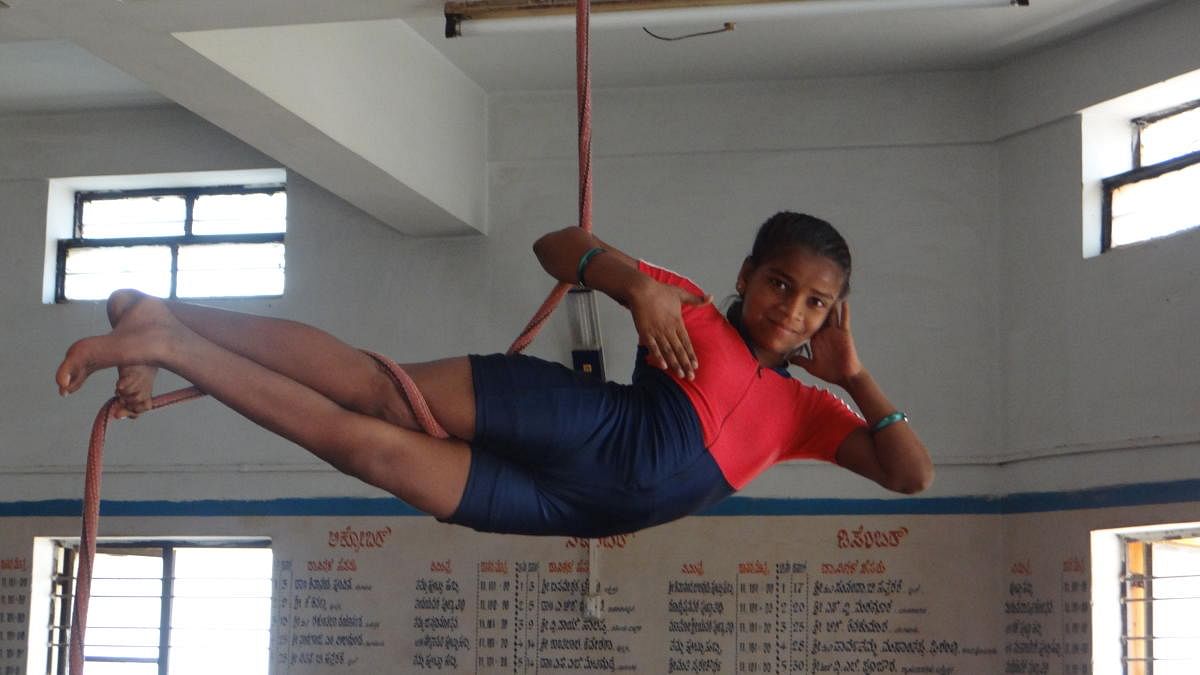Roping in some balance...

Manikantha, a 13-year-old was swiftly trying to reach the tip of the Mallakamba pole, but an elderly person sitting in the audience alerted him to be careful and climb slowly. Listening to the words of caution, Manikanta said that god had not only taken away his eyes but also fear. So, he was not afraid of falling down from the pole. Before shifting his focus back on the pole, he quickly added that god had given him the strength to rise even if he fell down.
It was not Manikantha alone who was involved in this visually-appealing performance of the Mallakamba. There were other girls and boys performing as well. These youngsters who participated in the daredevil acts are visually challenged.
Gymnastic feats
While a boy took a padmasana at the edge of the pole and then bent backwards, the other boy courageously stood at the same edge raising his arms in a triumphant salute. A third boy hung from the pole like a bat and the fourth hung in another unique posture. By the end of the event, the boys had displayed almost all the yogic postures on the single pole. The members of the audience, who were initially apprehensive about the safety of these students and doubted their capability, were left awe-struck looking at the composure and boldness of the visually-challenged students.
These students are from Jnanasindhu Residential School for the visually challenged located at Holealur in Ron taluk of Gadag district. Though most of these students have not seen the world through their eyes since birth, they have developed the capacity and skills to gain expertise in Mallakamba. Their coordination, sense of timing, courage and enthusiasm in performing Mallakamba are such that it makes them special children. It reminds us of Manikantha’s words that god had taken away fear from them.
This school for the visually challenged was started in July 2010. Yoga athlete(yogi) Shivanand Kelur, his mother Tulasamma and his brother were instrumental in establishing it. A seer of the local Yacchareshwar Math and Bengaluru-based non-profit NEST(Nurturing and Educating for Social Transformation) extended support to set up the school. Slowly, this school earned the distinction of being the country’s first yoga school for the visually-challenged.
Initially, the school had just five students and two staff members. But today, it has more than 100 students and 10 teaching staff members. Of them, eight teachers are also visually-challenged. The school also imparts training to students in Braille-based reading and writing, computers, movement, handicrafts, sports, agriculture, music and other skills. But it lays special emphasis on yoga.
The school staff says that though the children cannot see yoga and Mallakamba performances through their eyes, they are trained through careful instructions.
“Learning Mallakamba was not an easy task for us. We have many a time fallen and hurt ourselves. We feel like we are floating in the air while on the pole. But then, we eventually learn to climb the pole or the rope by holding each other’s hands,” says Vidya Tadasgeri, a student.
Many of the students were rejected by their families. But the Kelur family has adopted them and helped them make something of themselves.
In 2010, students Saraswathi Kabadar, Bhimsi Kabadar and Ayyappa Antaknavar won the Yoga Siri award. In 2016, Tulsamma Kelur won the Rajyotsava award.
It can be tough
While visually-challenged students learning Mallakamba face one type of a difficulty, the children with auditory challenges face another. These children need to be perfect in face-reading as they cannot hear the other Mallakamba athletes while giving group performances. However, the students of B D Tatti Residential School for Hearing Impaired located at Laxmeshwar, the land of modern-day Mallakamba, have overcome all odds to learn and perform the sport.

“Teaching Mallakamba to special children needs skills. The teacher has to know sign language and at the same time know the sport well in order to teach the students. The instructors need a lot of patience as they have to first motivate the students and then begin with the lessons. Most of the students in such special schools lack self-confidence initially as they would have faced social rejection. It is important that we create an enthusiastic group of students and then train them,” says M I Kanake, who had initially trained the students through his camps.
He opines that the students and instructors work hard to achieve such a feat and so they need more encouragement, both morally and financially, to reach greater heights.
Set up in 1996-97, this school run by Shri B D Tatti (Annavaru) Memorial Charitable Trust, had just 10 students at the beginning. But now has over 200 students. The school provides formal education to its students who face issues regarding hearing, aside from teaching Mallakamba. This school has a seprate team for girls and boys. That apart, its students have also competed with youngsters from mainstream schools. And, while boys perform these various feats on the pole, women predominantly perform on the rope. That said, the sport is accommodating and has both men and women performing across various platforms.
(Translated with inputs by Divyashri Mudakavi)
Deccan Herald is on WhatsApp Channels| Join now for Breaking News & Editor's Picks